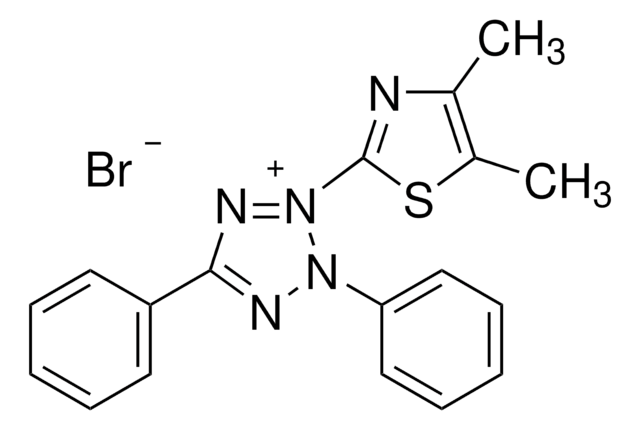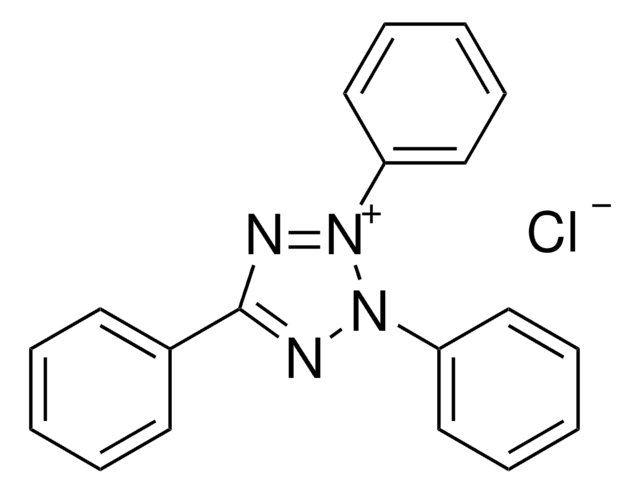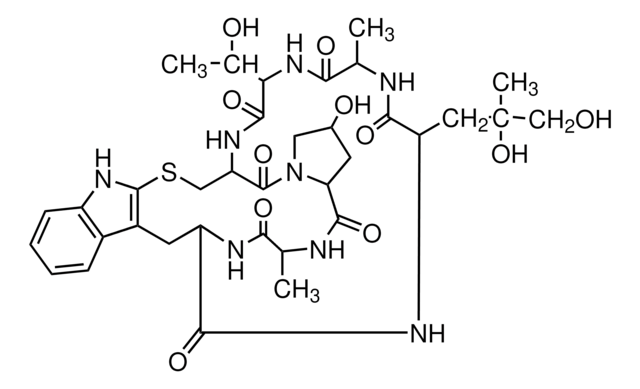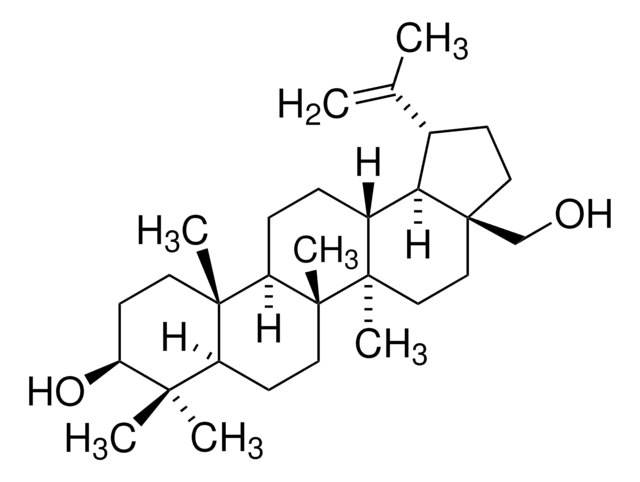50556
Phalloidin–Atto 390
BioReagent, suitable for fluorescence, ≥90% (HPLC)
Sinónimos:
Atto 390–Phalloidin
Iniciar sesiónpara Ver la Fijación de precios por contrato y de la organización
About This Item
UNSPSC Code:
12352116
NACRES:
NA.32
Productos recomendados
product line
BioReagent
Quality Level
assay
≥90% (HPLC)
manufacturer/tradename
ATTO-TEC GmbH
λ
in methanol
UV absorption
λ: 382-388 nm Amax
suitability
suitable for fluorescence
storage temp.
−20°C
General description
Atto 390 Phalloidin is a novel fluorescent label with a coumarin structure. The dye is intended for application in the area of life science, e.g. labeling of DNA, RNA or proteins. Characteristic features of the label are high fluorescence quantum yield, large Stokes-shift, good photostability and low molecular weight.Phalloidin is a fungal toxin isolated from the poisonous mushroom Amanita phalloides. Its toxicity is attributed to the ability to bind F actin in liver and muscle cells. As a result of binding phalloidin, actin filaments become strongly stabilized. Phalloidin has been found to bind only to polymeric and oligomeric forms of actin, and not to monomeric actin. The dissociation constant of the actin-phalloidin complex has been determined to be on the order of 3 x 10–8. Phalloidin differs from amanitin in rapidity of action; at high dose levels, death of mice or rats occurs within 1 or 2 hours.
Application
Fluorescent conjugates of phalloidin, rhodamine-phalloidin staining reagents, such as Phalloidin–Atto 390 are used to label actin filaments for histological applications. Some structural features of phalloidin are required for the binding to actin. However, the side chain of amino acid 7 (g-dihydroxyleucine) is accessible for chemical modifications without appreciable loss of affinity for actin.
Legal Information
This product is for Research use only. In case of intended commercialization, please contact the IP-holder (ATTO-TEC GmbH, Germany) for licensing.
Storage Class
11 - Combustible Solids
wgk_germany
WGK 3
flash_point_f
Not applicable
flash_point_c
Not applicable
ppe
Eyeshields, Gloves, type N95 (US)
Elija entre una de las versiones más recientes:
¿Ya tiene este producto?
Encuentre la documentación para los productos que ha comprado recientemente en la Biblioteca de documentos.
Chloé Clouzeau et al.
Molecular vision, 18, 851-863 (2012-04-25)
Benzalkonium chloride (BAK), the most commonly used preservative in eye drops, is known to induce ocular irritation symptoms and dry eye in long-term treated patients and animal models. As tear film hyperosmolarity is diagnostic of some types of dry eye
Y Ren et al.
Archives of biochemistry and biophysics, 323(1), 205-214 (1995-10-20)
Prostaglandin H synthase-1 is an integral endoplasmic reticulum membrane protein which catalyzes a key control step in prostaglandin biosynthesis. The overall arrangement of the prostaglandin H synthase-1 polypeptide with respect to the endoplasmic reticulum membrane was examined in transiently transfected
Małgorzata Maksymowicz et al.
Cell communication and signaling : CCS, 18(1), 176-176 (2020-11-06)
Lymphotoxin β receptor (LTβR) is a member of tumor necrosis factor receptor (TNFR) superfamily which regulates the immune response. At the cellular level, upon ligand binding, the receptor activates the pro-inflammatory NF-κB and AP-1 pathways. Yet, the intracellular distribution of
Stimulated emission depletion-based raster image correlation spectroscopy reveals biomolecular dynamics in live cells.
Hedde P.N.; et al.
Nature Communications, 4, 2093-2093 (2013)
SNARE Function Is Not Involved in Early Endosome Docking.
Geumann, U.; et al.
Molecular Biology of the Cell, 19(12), 5327-5337 (2008)
Contenido relacionado
Atto dyes are a series of fluorescent dyes that meet the critical needs of modern fluorescent technologies
Nuestro equipo de científicos tiene experiencia en todas las áreas de investigación: Ciencias de la vida, Ciencia de los materiales, Síntesis química, Cromatografía, Analítica y muchas otras.
Póngase en contacto con el Servicio técnico






